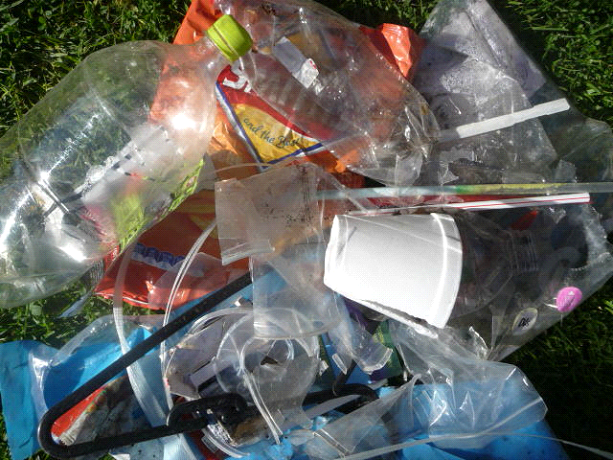Try biodegradable plates, cups
Posted on March 14, 2012 by DrRossH in BioPlasticsTry biodegradable plates, cups | Pacific Daily News | guampdn.com.
The biodegradable plastics business is not as simple as this reports makes out. And it made quite a bit more complicated by various manufacturers and over zealous sales people adding confusion to the pot. There are only two types of biodegradable plastics. Compostable or commonly now called Bioplastics which are plastics made from plants. And secondly landfill-biodegradable plastics which are made from conventional plastics with a small amount of an organic additive added to them.
1) Bioplastics will biodegrade only in a commercial compost facility where a temperature of 60 deg C and plenty of oxygen is maintained on the windrows and moisture. If these conditions are not met, the plastic will not biodegrade. They do not biodegrade in home compost piles due to the incorrect conditions attained in these piles. This is a attribute that the bioplastic manufacturers do not readily let on. They like the perception of the ‘green plastics as they are made from plants’ pervade the market. People think that anything made from plants has to biodegrade. This is not true however. So unless the people in Guam have very accessible access to a commercial composting facility and are prepared to go out there with their plates and cups to drop them off, these items will not be biodegrading.
2) Landfill-biodegradable plastics are conventional plastics with this additive in them. The additives has no effect until the plastic is disposed to a landfill, in which the natural microorganisms ae then attracted to the additive and in the process of that, they break down the large plastic molecules and then digest them too. The process is slow, it could take 5 years or so for a plate to biodegrade away. The main point to consider however is that it will biodegrade way. One generation should not be leaving its trash for future generations to deal with. While all the first efforts should be aimed a getting plastics recycled, if for some reason they are not, there are some good advantages with landfill-biodegradable plastics too. 1) They can be recycled in mainstream plastics. So whether you recycle them or dispose to a landfill either way the plastic will be gone. 2) There are no shelf life issues. They can be stored on a shelf like the same conventional plastic. 3) The additive can be added to most types of plastic, HDLE, PE, PVC etc. 4) The cost difference is negligible 5) Being virtually the same as conventional plastics, their physical properties are unaffected. 6) They additives have been approved to FDA standards for food contact.
(Note landfill biodegradable additives are not to be confused with oxodegradable additives which some people do, as oxodegradable additives cause plastic to fragment into small pieces and then you have a lot of little bits of plastic loose in the environment. They have not been proven to biodegrade either).

 How many people today grab a takeaway coffee cup from the local cafe to drink on the go? We don’t know, but the number must be enormous.. Most every one of the above have a plastic top that will last 100s of years. Some cafes still use plastic cups that last a similar time. Is 10 minutes of coffee worth 100s of years of trash?
These items can be seen littering our gutters and on our streets all over the place. If they were all cardboard, they would still be littered, but they would, at least, be gone in a short time.
They do not need to be made of plastic.
How many people today grab a takeaway coffee cup from the local cafe to drink on the go? We don’t know, but the number must be enormous.. Most every one of the above have a plastic top that will last 100s of years. Some cafes still use plastic cups that last a similar time. Is 10 minutes of coffee worth 100s of years of trash?
These items can be seen littering our gutters and on our streets all over the place. If they were all cardboard, they would still be littered, but they would, at least, be gone in a short time.
They do not need to be made of plastic.
 On the way home from the gym last week, a distance of about 1 km (1/2 mile), I counted the items of plastic litter on the curb as I walked. In that short distance I counted 63 pieces of plastic litter. Plastic drink bottles, bottle tops, candy wrappers, plastic film, polystyrene fragments etc. That seemed to be a lot to me. I guess it is a generational thing. Our parents would have been horrified to see that amount, whereas it seems to go unnoticed by our youth of today. In another 20 years how many pieces will there be on this stretch, -- 200? What will today’s youth think of that new amount then when they are older? Will their children be so readily accepting of a higher amount of litter?
On the way home from the gym last week, a distance of about 1 km (1/2 mile), I counted the items of plastic litter on the curb as I walked. In that short distance I counted 63 pieces of plastic litter. Plastic drink bottles, bottle tops, candy wrappers, plastic film, polystyrene fragments etc. That seemed to be a lot to me. I guess it is a generational thing. Our parents would have been horrified to see that amount, whereas it seems to go unnoticed by our youth of today. In another 20 years how many pieces will there be on this stretch, -- 200? What will today’s youth think of that new amount then when they are older? Will their children be so readily accepting of a higher amount of litter?
Laura says:
Post Author March 18, 2012 at 3:34 pmAs a web site owner I think the material here is really magnificent. I appreciate it for your time. You must maintain it and keep it up forever! Excellent work.
Ahighbloodpressurediet.com
Virmanz says:
Post Author April 7, 2012 at 3:30 amThis article is elnelxect but I would like to know more about what I can do. Can youplease have this author continue writing similar pieces? The tone wasn’t judgmental to those of us who have yet to make these types of changes but authoritative enough tomake me think about wanting to. Interesting piece.
John says:
Post Author April 7, 2012 at 2:36 am[P]rovide chicken fraemrs a new place to sell the nearly 3 billion pounds of chicken feathers they accumulate yearly. 3 billion pounds of chicken feathers! Unfathomable. I’d like to hear some elaboration on these, for a lack of a better word, quirky alternatives to oil use. A nice, green little read.